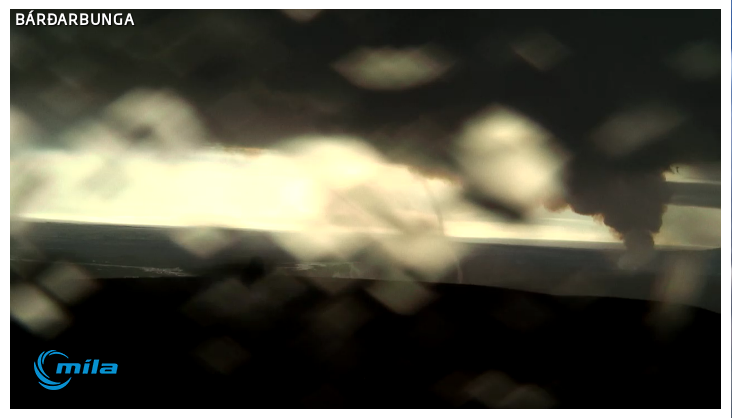This information is going to go outdated quickly.
Current status in Bárðarbunga volcano at 16:36 UTC
- The largest earthquake in past 24 hours took place yesterday (16-September-2014) at 21:34 UTC. It had the magnitude of 5,4. The largest earthquake today had the magnitude of 3,3 so far. This might change without warning.
- Lava continues to flow out of the main crater in Holuhraun. The eruption is diminishing for the moment. That might change without warning if an new fissure opens up in the current eruption area, or in the glacier south of it. River of lava has been observed from the main erupting crater. Smaller craters that have stopped erupting are just emitting gas, two of three of the craters that have stopped erupting have lava lake in them at present time (latest report).
- GPS data over the past few days suggest that magma flow into Bárðarbunga volcano is changing. I don’t think this is a good news. At the moment it is unclear what this means for current eruption and what is happening in the volcano.
- Bárðarbunga volcano caldera continues to drop around 50cm/day at current rate. That is slightly slower than when it was dropping at the rate of 90cm/day about week ago.
- Risk of eruptions under the glacier remains high and it is highly likely that eruptions might have happened under the glacier without anyone noticing them on the surface.
- No major changes have taken place in glacier rivers that come from Bárðarbunga volcano area. Both when it comes to conductivity of water in the glacier rivers and amount of water in them.
- There is currently no visibility to the eruption in Holuhraun due to thick fog in the area. I don’t know when the weather is going to clear up.
- More magma continues to flow into the dyke than is erupting from it according to latests observations. This increases the risk of new eruption taking place along the dyke without warning.
Progress of the current activity
The eruption is happening in two parts in my view. The first part is the rifting episode that has now started in Bárðarbunga volcano fissure swarm. The rifting is going to happen in jumps with quiet period between them and the crust is going to crack or open up when that happens. This rifting has started in the northern part of Bárðarbunga fissure system. It has not yet started in the south part of the fissure, where features like Tröllagígar are (Tröllagíar crater row) exist. They erupted in the years 1862 – 1864. That magma that came up there closely resembles the magma that is now erupting in Holuhraun.
The second event that is happening is the collapse of Bárðarbunga volcano caldera. I now think that is an separate event in it self. Something must have happened in the volcano during past period of activity in 19th century that started this collapse, even if it did not start full force until current eruption episode. The caldera collapse is not going to stop the rifting process, that is going to run it course of the next few years (3 – 5 years is my best estimate now). This collapse is however going to make bad situation worse since when the collapse happens it is going to be a major problem for the local area. Since the area south of Bárðarbunga also has several hydro-dams that are in risk of some major damage, not just from fissure eruptions but also from glacier floods when they happen. In glacier floods triggered by eruption contain a lot more than just water. Glacier floods contains fragment of the glacier, many up to several meters high (20 – 60 meters high should be expected), mud, glacier clay, rocks, volcano material of all types, gases and several other things that I don’t know what are.
Current status at 18:45 UTC.
- Bárðarbunga volcano has dropped 25 meters according to measurements taking today by University of Iceland and Icelandic Met Office. The speed of the drop in Bárðarbunga volcano caldera has slowed down from what it was about a week ago.
- Currently the dyke from Bárðarbunga volcano is not expanding. Scientists are also not sure now how much lava has erupted at current time.
Current status at 23:56 UTC
- There seems to be quiet period in the rifting episode at the moment. Along with general quiet period in Bárðarbunga volcano. It does not mean this is over, the eruption in Holuhraun continues and I continue to see harmonic tremor spikes taking place. I don’t know what the harmonic tremor spikes mean yet.
- Largest earthquakes now have the magnitude of 4,1 (at 22:51 UTC) and magnitude 3,2 earthquake at 22:28 UTC.
Article updated at 16:56 UTC. Minor fixes that I needed to do on the text.
Article updated at 18:45 UTC.
Article updated at 18:48 UTC.
Article updated at 23:56 UTC.




